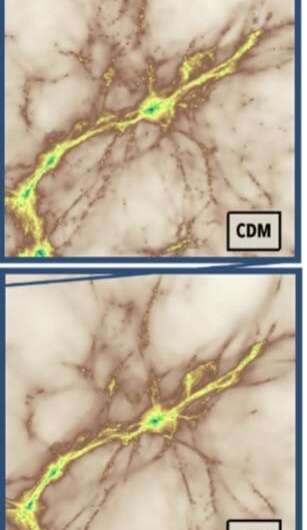Looking for warm dark matter

In the last century, astronomers studying the motions of galaxies and the character of the cosmic microwave background radiation came to realize that most of the matter in the universe was not visible. About 84% of the matter in the cosmos is dark, emitting neither light nor any other known kind of radiation. Hence it is called dark matter. One of its other primary qualities is that it only interacts with other matter via gravity: it carries no electromagnetic charge, for example. Dark matter is also "dark" because it is mysterious: it is not composed of atoms or their usual constituents like electrons and protons. Particle physicists have imagined new kinds of matter, consistent with the known laws of the universe, but so far none has been detected or its existence confirmed. The Large Hadron Collider's discovery of the Higgs boson in 2012 prompted a burst of optimism that dark matter particles would soon be discovered, but so far none has been seen and previously promising classes of particles now seem to be long-shots.
Astronomers realize that dark matter is the dominant component of matter in the universe. Whatever its nature, it profoundly influenced the evolution of galactic structures and the distribution of the cosmic microwave background radiation (CMBR). The remarkable agreement between the values of key cosmic parameters (like the rate of expansion) derived from observations of two completely different kinds of large-scale cosmic structures, galaxies and the CMBR. lend credence to inflationary big bang models that include the role dark matter.
Current models of dark matter presume it is "cold," that is, that it does not interact with any other kinds of matter or radiation—or even with itself—beyond the influences of gravity. This version of cosmology is therefore called the cold dark matter scenario. But cosmologists wonder whether more precise observations might be able to exclude even small levels of interactions. CfA astronomer Sownak Bose led a team of colleagues in a study of one very popular (if speculative) "dark matter" particle, one that has some ability to interact with very light particles that move close to the speed of light. This version forms one of several possible warm dark matter (perhaps more accurately called interacting dark matter) scenarios. In particular, the hypothetical particles are allowed to interact with neutrinos (neutrinos are expected to be extremely abundant in the hot early universe).
The scientists used state-of-the-art cosmological simulations of galaxy formation to a model universe with this kind of warm dark matter. They find that for many observations the effects are too small to be noticeable. However, the signature of this warm dark matter is present in some distinct ways, and in particular in the way distant galaxies are distributed in space, something that can be tested by mapping galaxies by looking at their hydrogen gas. The authors conclude that future, highly sensitive observations should be able to make these tests. Detailed new maps of the distribution of hydrogen gas absorption could be used to support—or exclude—this warm dark matter possibility (see the figure), and shed light on this mysterious cosmic component.
More information: Sownak Bose et al. ETHOS – an Effective Theory of Structure Formation: detecting dark matter interactions through the Lyman-α forest, Monthly Notices of the Royal Astronomical Society (2019). DOI: 10.1093/mnras/stz1276
Journal information: Monthly Notices of the Royal Astronomical Society
Provided by Harvard-Smithsonian Center for Astrophysics





















